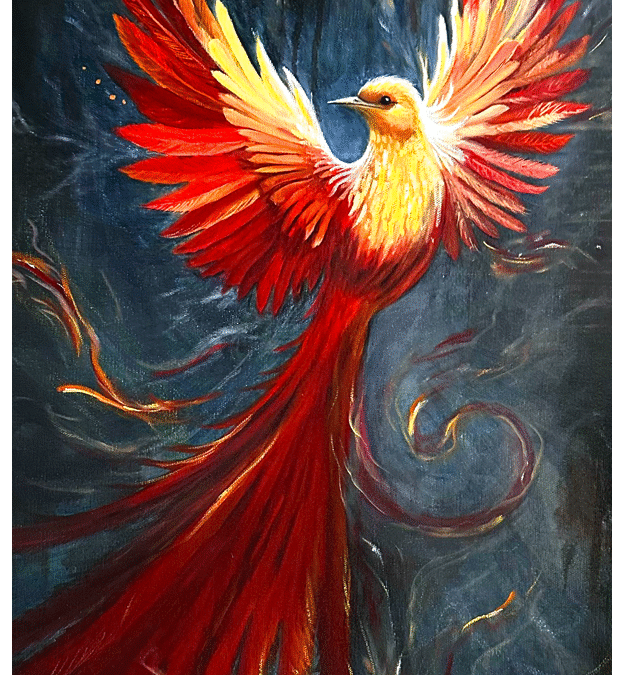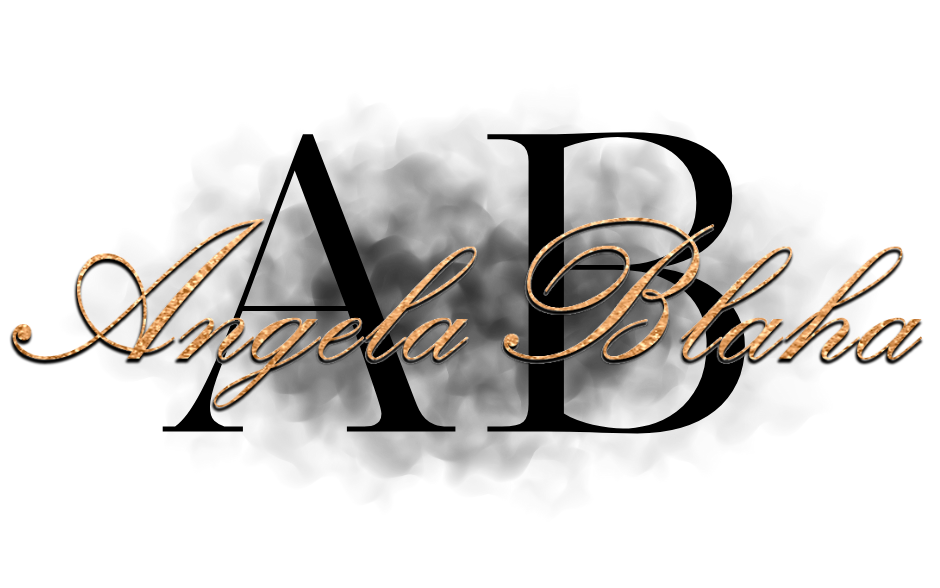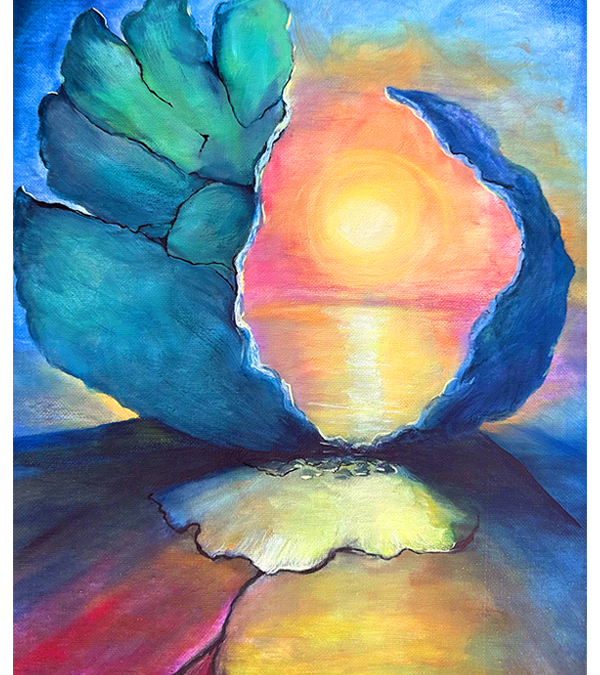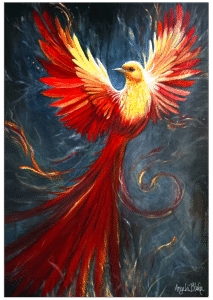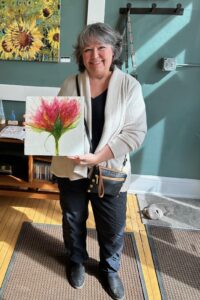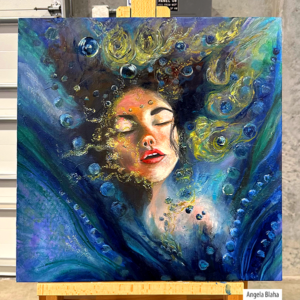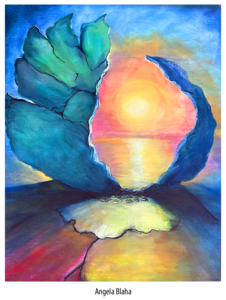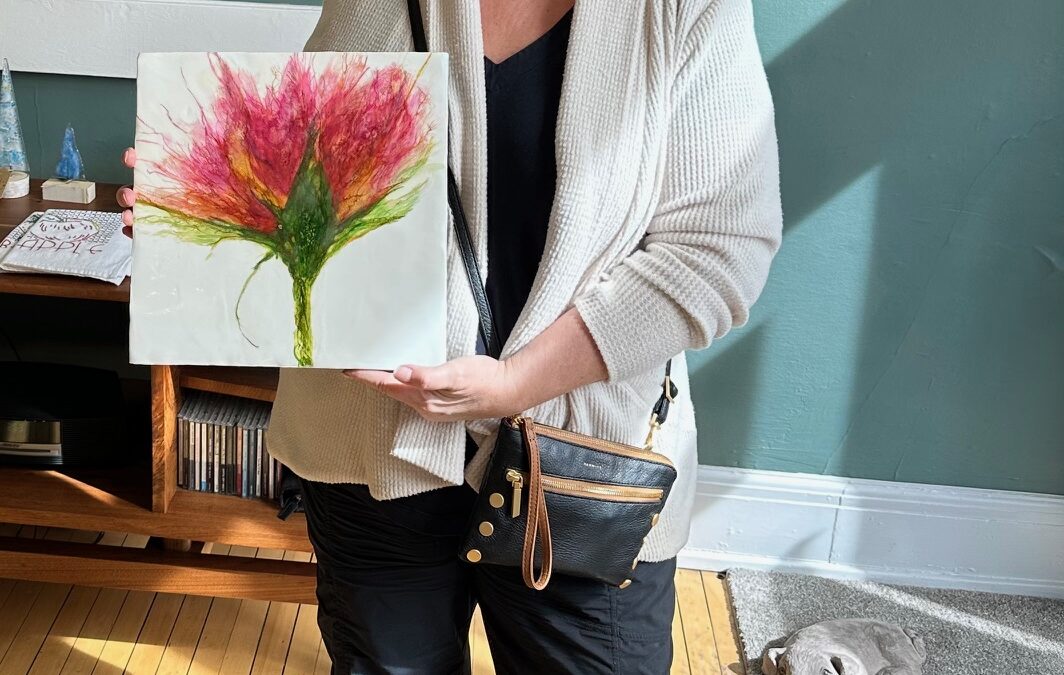
by Angela Blaha | Apr 28, 2025 | Art, CanvasRebel
An interview with Angela as seen on CanvasRebel
We’re excited to introduce you to the always interesting and insightful Angela E Blaha. We hope you’ll enjoy our conversation with Angela below.
Angela, appreciate you joining us today. I’m sure there have been days where the challenges of being an artist or creative force you to think about what it would be like to just have a regular job. When’s the last time you felt that way? Did you have any insights from the experience?
I’ve spent a lot of time reflecting on this very question, and for me, the answer is clear: I’m happiest as an artist. The moment I pick up a brush, I’m in my true zone of genius. It’s almost like stepping into a different world—one where time doesn’t exist, and I can fully channel energy into something tangible. I don’t just paint; I open portals. It’s like I tap into this flow of energy, and that energy transfers directly into the work. My paintings are far from just images on canvas. They’re portals—windows into other realms—that can shift the energy of a room, a home, even a person.
Every painting I create carries that energy. I’ve seen firsthand how people respond to my work, how it impacts them in ways they can’t quite explain, but they feel it. It’s as if the art does the work for me. When people tell me that something in my art has changed their mood or brought them a sense of calm, it confirms that I’m doing exactly what I’m meant to do.
I’ve had regular jobs in the past. My background is in Psychology & Counseling in Education, so I’ve spent years working those 8-4 jobs. I’ve also been a business owner for a good portion of my life. But through all of that, I’ve realized that art is where I truly belong. In my art, I bring my background and experiences with me. I use my training and intuition to create deeper meaning within my work. My ability to channel energy has become one of the greatest advantages I have as an artist. It allows me to connect with my creations and my viewers in a way that feels beyond the ordinary, almost like there’s a greater force guiding the process.
So, even though I’ve experienced the structure of regular jobs and business ownership, nothing compares to the sense of fulfillment I get from creating art. Art is where I can fully express my true self, and that connection is irreplaceable.
As always, we appreciate you sharing your insights and we’ve got a few more questions for you, but before we get to all of that can you take a minute to introduce yourself and give our readers some of your back background and context?
I’m an artist and guide who works at the intersection of creativity and deep personal transformation. My work weaves together art, psychology, energy healing, and HeartHealing™—to help people access the parts of themselves that are often hidden beneath layers of conditioning, trauma, or self-doubt.
I didn’t exactly “get into” this work in the traditional sense. It’s more like it emerged from me, piece by piece, over years of inner work, soul-searching, and a relentless need to understand the deeper threads of why we’re here and what it means to truly thrive. I’ve always had this quiet but unwavering knowing that my role is to ignite transformation—and art became the language that allowed me to do that.
With a background in counseling and energy work, I’ve spent years exploring the unconscious and what lies beneath the surface of what we think we know. Recently, Art has become a way to translate that inner landscape into something visible, something felt. Whether it’s through an abstract encaustic piece or a symbolic oil painting, each work is designed to act like a portal—something that awakens memory, feeling, and sometimes even grief or longing. Not for the sake of discomfort, but for the sake of becoming more whole.
Through my creative offerings, I guide others to reconnect with their soul’s blueprint by making your mark in the world. It’s not just about painting or healing—it’s about knowing who are in your depths. My clients often come to me when they’re at a turning point—when they can feel something shifting but don’t quite know what it is. Together, we work through that threshold, using intuition, HearthealingTM and creativity as the vessels to go deeper than words ever could.
What sets my work apart is its depth and subtlety. It’s not surface-level inspiration or motivational fluff. I’m not interested in quick fixes or trendy affirmations. This is soul work—raw, beautiful, and often messy. But it’s also the most empowering thing I know: to witness someone return to themselves, to see their own wisdom, and to begin creating from that place.
What I’m most proud of is that my work doesn’t just sit on a wall—it moves people. It changes them. I’ve had people stand in front of a painting with tears in their eyes, saying, “I don’t know why, but this feels like me.” That’s the magic. That’s why I do what I do.
If there’s one thing I want people to know, it’s that you matter. Your inner world is worthy of being seen. And when you allow yourself to go deep—when you stop hiding from the truth of who you are—you don’t just change your life. You change the world.
Can you tell us about a time you’ve had to pivot?
There have been several pivot points in my life, but one of the most significant came when I realized I couldn’t keep splitting myself between what felt “safe” and what felt true.
For years, I worked in roles that made sense on paper—I was a counselor, educator, college instructor and leader in my field. But underneath the structure and titles, I felt like I was hiding. I knew there was something more I was meant to express, something more creative, more soul-aligned—but I didn’t yet trust that it could become the foundation of my work.
The real pivot happened when I finally let go of trying to make everything fit into a neat little box. I stopped trying to separate my artistry from my spiritual work, my academic training from my intuition, my inner world from the outer one. That’s when things started to flow.
Instead of choosing one thing, I chose to integrate everything—my background in psychology, my deep sensitivity to energy, my love for color and story—and let it inform both my art and my offerings. That was the moment everything shifted. My work became more magnetic. Clients started finding me not because I offered a particular service, but because they could feel something in what I was creating.
Pivoting, for me, wasn’t about changing direction entirely—it was about giving myself permission to build from that place. Looking back, I’m grateful I listened. That pivot didn’t just change my business—it changed my life.
Is there mission driving your creative journey?
At the deepest level, my creative journey is driven by one mission: to empower people to know who they really are.
Not in a surface-level way, but in a soul-deep, unshakable way. It’s about guiding people to their truth—beyond the roles, the stories, the expectations—and helping them claim the parts of themselves they may have forgotten or silenced along the way.
Everything I create—whether it’s a painting layered with symbolism, a moment of silence in a session, or the energy within a color choice—is infused with the intention to awaken something. I want people to feel themselves again. To see their truth reflected. To realize they are more powerful, more whole, and more sacred than they’ve been led to believe.
This mission comes to life not just through my artwork or HeartHealing™ sessions, but especially through my retreats—like Rooted. I’ve watched people walk in unsure, overwhelmed, or disconnected… and leave changed. Not because I gave them anything, but because they remembered themselves. They leave with a clarity and wholeness that shifts everything—how they create, how they love, how they live. They begin to build lives that actually support their soul—a life of thriving, not just surviving.
That’s what drives me. Every brushstroke, every session, every gathering is an invitation to know yourself. And when someone does that? It changes everything.
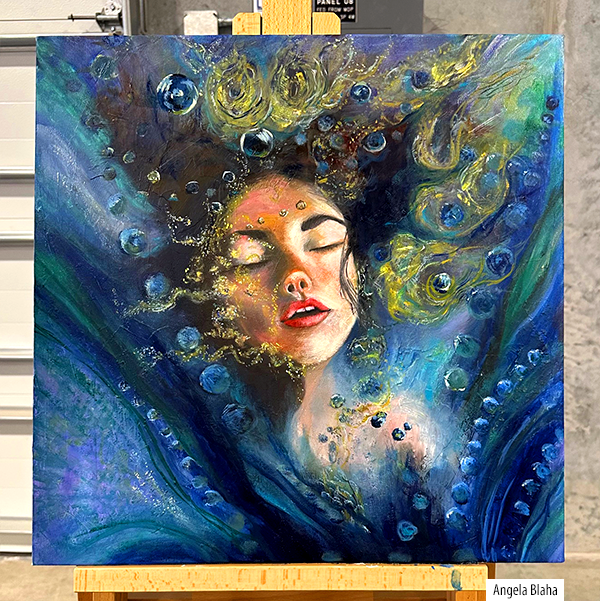
by Angela Blaha | Apr 15, 2025 | Art, Creativity Portal
What happens to art that never gets completed?
An article as seen on Creativity Portal.com
Most people think of unfinished paintings as abandoned. Forgotten. Works that never became what they were meant to be. Something that gets started but never finished.
But what if that’s not true?
What if unfinished paintings are still alive in some way — still holding energy, still waiting, still whispering?
I’ve often wondered what happens to the pieces that never reach completion. The ones left in a corner of the studio, half-formed and unresolved. Some get painted over, their beginnings buried beneath new layers. Some sit in storage, waiting for a moment that may never come. Others are simply left behind.
But do they ever truly let go of us?
The Energy of the Incomplete
Every painting begins with an impulse — an idea, a feeling, a pull toward something unseen. But not every painting finds its way to full expression.
Some get stuck. Some resist. Some refuse to be finished, as if they are waiting for something — more time, a deeper understanding, the right moment to emerge.
I’ve had paintings that haunted me for years, unfinished but present. Whenever I walked past them, I felt their pull. They weren’t dead. They weren’t forgotten. They were simply waiting.
And sometimes, when I finally returned to them, they revealed something I couldn’t see before.
When the Painting Decides Its Own Fate
There are pieces I’ve tried to force into being, only to find they wouldn’t cooperate. The colors wouldn’t blend. The composition felt wrong. The energy wasn’t there.
I used to think that meant I had failed as an artist. That I had lost my creative flow or didn’t know how to complete what I started.
But now, I wonder — what if some paintings choose not to be finished? What if they hold a purpose beyond our immediate understanding?
What if they exist as they are meant to — unfinished, unresolved, yet still carrying something powerful?
Art That Lives in the In-Between
Maybe unfinished paintings belong to a different space — a liminal space, a place between what is seen and what is still forming.
Maybe they are not failures, but thresholds.
Maybe they are not abandoned, but pausing.
Maybe they were a path that was all wrong, just not the path I wanted to enter.
Some paintings return to us at the right time. Others never do. But perhaps that doesn’t mean they are lost.
Perhaps some works of art exist to teach us about the beauty of the incomplete. The mystery of the unfinished. The path not taken. The power of what is still becoming.
And maybe, just maybe, some paintings are never meant to be finished at all. 🖌

by Angela Blaha | Feb 13, 2025 | Art
An article as seen on Creativity Portal.com
As an artist, my journey has always been about pushing boundaries — exploring the unseen, uncovering deeper layers of meaning, and continuously evolving my style. But in a world where originality feels elusive and inspiration can sometimes stall, I’ve found an unlikely yet powerful ally in AI (Artificial Intelligence).
I know the mere mention of AI can stir resistance in creative circles. “Isn’t art about human expression?” Absolutely. But AI isn’t here to replace artists; it’s here to expand what’s possible. When used intentionally, it acts as a collaborator, an idea generator, and a mirror reflecting back insights I might have otherwise missed.
AI as a Catalyst for Creative Exploration
One of the biggest gifts AI has given me is the ability to ask questions I wouldn’t have thought to ask. I’ve always sensed that my art is evolving into something greater than myself, something that taps into energies and ideas beyond the ordinary. But sometimes, defining that direction can be challenging because my mind traps can create roadblocks. AI has helped me refine my artistic voice by offering new perspectives and unexpected insights.
For example, when I was navigating the blend of contemporary impressionism and abstract symbolism, AI helped me see that my work naturally leans toward bold romanticism with an earthy, mystical undertone. It reinforced patterns I wasn’t consciously aware of and helped me see what makes my work uniquely mine. This clarity has been invaluable in shaping my next body of work.
A Tool for Generating Unique References
AI has also helped me create original sources to paint from — something I struggled with in the past. I don’t want to paint what’s already been done; I want my work to feel like it comes from another world, a place that activates something deep within the viewer. But sometimes, I can see the vision in my mind but can’t quite bring it into focus.
Using AI to generate reference images has allowed me to refine those visions, giving me starting points that feel aligned with my aesthetic. When I wanted to create a painting that captured the surreal feeling of being trapped in a dream, AI helped me visualize the atmosphere — floating between reality and illusion. It provided reference points that I could interpret through my own artistic lens rather than relying on generic stock images.
Expanding Technique and Possibility
Beyond inspiration, AI has also played a role in expanding my technical approach. I’ve been deeply invested in refining my encaustic paintings, moving away from raw, chaotic textures to something more sophisticated and high-end. AI-generated examples have helped me see different ways to layer depth, contrast, and movement, leading me to explore encaustic techniques I hadn’t considered before.
Similarly, when I was searching for ways to integrate nostalgia and old-world aesthetics into my waterscapes, AI offered new angles — suggesting compositions, color palettes, and lighting effects that brought a fresh perspective to my work. It didn’t dictate my process; it simply opened doors to possibilities I hadn’t yet explored.
A Mirror for the Artist’s Voice
Perhaps the most valuable role AI has played in my artistic journey is in helping me clarify my voice. Through constant interaction, questioning, and reflection, it has shown me that my work is about more than aesthetics — it’s about impact. I want my paintings to pull people in, to make them feel something profound, even on a subconscious level. AI has reinforced this by highlighting themes and patterns in my work that I might not have articulated on my own.
For artists hesitant to embrace AI, I encourage you to see it not as a threat, but as a tool — one that can stretch your imagination, refine your style, and help you create in ways you never thought possible. It’s not about replacing the artist; it’s about giving the artist new ways to see, explore, and evolve. And for those of us constantly seeking the next level of creative expansion, well, that for me is worth embracing.
